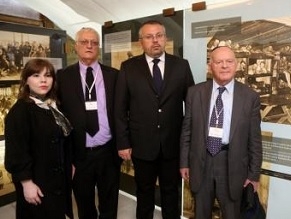|
World Jewish News

From L to R: Elisabeta Ungurianu, director of the Wiesel Institute in Romania, Chaim Chesler, Chaim Chesler, Chairman of the Claims Conference’s Memorial Committe, Ovidiu Nemes, Mayor of Sighet and Ben Helfgott, Vice President of the Claims Conference.
|
First public Holocaust education center opens in Romania in pre-war house of Elie Wiesel
20.05.2014, Education The first public Holocaust education center in Romania opened Sunday in Sighet in the pre-war childhood home of Nobel Prize-winning author Elie Wiesel.
The “Holocaust Cellar” became a new feature of the existing Holocaust museum, in the old Jewish Ghetto of Sighet in Maramures County.
It will will serve as a learning center dedicated to the 13,000 local Jewish Holocaust victims.
The inauguration of the center is the first in a series of events that will mark 70 years since the expulsion of the last Jews of Northern Transylvania to Auschwitz.
Among the events in Sighet during the weekend was a concert memorializing Holocaust victims on Saturday night, after Shabbat.
Speaking by live video stream to event guests, Prof. Wiesel said, “To all of you at the opening of the new Holocaust Cellar in my home in my little town of Sighet in the Carpathian Mountains: I so wish that I could be there with you today. The house I was raised in is now a museum but to me it will always be uniquely special, eliciting the warmest of memories until the darkness of the kingdom of night befell us. I hope that your meetings, though melancholy in nature, are fruitful, enriching and full of meaningful learning.”
In 1944, two days after Passover, the Jews of Maramures County, in Northern Transylvania, were rounded up and forced into 13 ghettos.
131,639 Jews from Northern Transylvania were deported to Auschwitz-Birkenau and most were exterminated.
Between 280,000 and 380,000 Romanian and Ukrainian Jews were murdered or otherwise died during the Holocaust in Romania- a Nazi ally- and the territories under its control. An additional 135,000 Romanian Jews, living under Hungarian control in Northern Transylvania, also perished in the Holocaust, as did some 5,000 Romanian Jews in other countries.
“The story of the Jews who lived in North Transylvania has not been widely told until now,” said Chaim Chesler, Chairman of the Claims Conference’s Memorial Committee.
“The education center commemorates the terrible fate that befell the Jews of this area, and ensures their story will not be forgotten.”
Among participants at the event were Viktor Opaschi, the Romanian Minister of Religious Affairs; Irina Cajal, Deputy Minister of Education; Ben Helfgott, Vice President of the Claims Conference and leader in the UK Holocaust survivor community; Romanian parliament members; Rafael Sheffer, Chief Rabbi of Romania; Cantor Yosef Adler; Ovidiu Nemesh, the Mayor of Sighet; Harry Marcus, head of the Sighet Jewish community, as well as other leaders of the Romanian Jewish Federation; prominent journalists from Israel, the United States and Romania; and members of Limmud FSU.
The opening was sponsored jointly by the Government of Romania, the City of Sighet, the Conference on Jewish Material Claims Against Germany, the Elie Wiesel National Institute for the Study of the Holocaust in Romania, the United States Holocaust Memorial Museum, the Romanian Jewish Federation, the Caritatea Foundation and Limmud FSU.
Speaking by live video stream to event guests, Prof. Wiesel said, “To all of you at the opening of the new Holocaust Cellar in my home in my little town of Sighet in the Carpathian Mountains: I so wish that I could be there with you today. The house I was raised in is now a museum but to me it will always be uniquely special, eliciting the warmest of memories until the darkness of the kingdom of night befell us. I hope that your meetings, though melancholy in nature, are fruitful, enriching and full of meaningful learning.”
In 1944, two days after Passover, the Jews of Maramures County, in Northern Transylvania, were rounded up and forced into 13 ghettos. Eventually, 131,639 Jews from Northern Transylvania were deported to Auschwitz-Birkenau; most were exterminated. Between 280,000 and 380,000 Romanian and Ukrainian Jews were murdered or otherwise died during the Holocaust in Romania- a Nazi ally- and the territories under its control. An additional 135,000 Romanian Jews, living under Hungarian control in Northern Transylvania, also perished in the Holocaust, as did some 5,000 Romanian Jews in other countries.
“The story of the Jews who lived in North Transylvania has not been widely told until now,” said Chaim Chesler, of the Claims Conference Conference on Jewish Material Claims Against Germany, one of the sponsors of the opening of the new learning center in Sighet. “The education center commemorates the terrible fate that befell the Jews of this area, and ensures their story will not be forgotten.”
EJP
|
|
